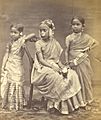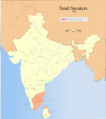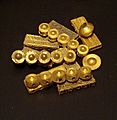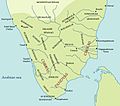Tamil people facts for kids
| Total population | |
|---|---|
| 77,000,000 | |
| Regions with significant populations | |
| 60,793,814 (2001) | |
| 4,092,676 (2001) | |
| 2,900,000 (2007) | |
| 200,000 (2007) | |
| 436,550 (2006) | |
| Languages | |
| Tamil | |
| Religion | |
| 88% Hindu, 6% Muslim, 5.5% Christian. | |
| Related ethnic groups | |
| Dravidians · Telugus · Kannadigas · Tuluvas · Malayalis · Giraavarus · Sinhalese | |
The Tamil people are a large group of people who come from South Asia. They have lived for a long time in southern India and northeastern Sri Lanka.
Around 74 million Tamil people live in the world today. About 63 million of them live in India. About 3.6 million live in Sri Lanka, and 2.9 million live in Malaysia. Around 430,000 Tamil people live in Singapore. Many others live in different countries around the world.
Other groups of people are connected to the Tamils through their language, culture, and family history. Some of these groups include the Kannadigas, Malayalis, Telugu people, and Tuluvas.
Tamil people feel a strong connection to their language, Tamil. They also have a very rich culture and a long history of literature. Nowadays, the idea of "Tamil people" also includes those whose families spoke Tamil in the past, even if they don't speak it anymore.
Contents
History of the Tamil People
The history of the Tamil people can be looked at in three main time periods.
Ancient Tamil History: Early Times
No one knows for sure where the Tamil people first came from. Some experts think they might be connected to the Elamite people from ancient Iran. Historians have also found clues in old writings and town names from the Indus Valley civilization. These clues suggest that the people of the Indus Valley Civilization might have been Tamil.
In Tamil Nadu, which is a state in India, the earliest signs of Tamil people go back to about 10,000 BC. Archaeologists have found many ancient burial sites from the Megalithic era. The way these burials were done is similar to what is described in old Tamil literature. Recent digs at these sites have also found examples of early Tamil writing. Some of this writing might be as old as 5,000 BC.
Classical Period: Kings and Trade
During this time, three powerful royal families appeared in the Tamil lands. These were the Cholas, Cheras, and Pandyas.
Farming and trading were the main ways Tamil people made a living. They traded with many other countries, even places in Europe. In Karur, a city in Tamil Nadu, archaeologists found many old coins from Ancient Rome and Egypt. The Pandya kings even sent messengers to the Roman Emperor Augustus. Tamil writings have also been found on broken pieces of pottery in the Red Sea.
An unknown traveler from ancient Greece wrote about the ports of the Pandya and Chera kings. He described the things the Tamil people exported. These included black pepper, pearls, ivory, silk, diamonds, sapphires, and tortoiseshell.
The classical period ended around the 2nd century. People from northern India came into the Tamil lands. This time was known as the "dark period" for the Tamil people. It ended when the Pandyas and Pallava dynasties became powerful again.
Imperial and Later Periods: Empires and New Rulers
Many old records of ancient Tamil rulers were lost. We know more about the Pallava period starting from the 6th century. The Pallavas became strong after a time of conflict. They also encouraged the worship of the gods Shiva and Vishnu and built large temples.
In the 9th century, the Cholas and Pandyas defeated the Pallavas. By the 10th century, the Cholas had built a huge empire. It covered most of southern India and Sri Lanka. They had a strong navy that reached places like Thailand, Burma, and Sumatra. They also traded a lot with China.
By the 12th and 13th centuries, the Chola empire became weaker. For a while, the Pandyas became powerful again. However, Muslim rulers then started to invade Tamil lands. The Pandya dynasty ended around the 16th century.
Over time, the western parts of the Tamil lands developed differently. By the 13th century, the Cholas and Pandyas no longer controlled these areas. The people living there developed their own language and culture. By the 15th century, they had a separate language called Malayalam, which is now spoken in the Indian state of Kerala.
After the 16th century, no major rulers controlled all Tamil lands. Instead, there were many smaller local rulers. For some time, rulers from what are now Maharashtra and Andhra Pradesh also ruled parts of the Tamil lands. By the 17th century, Europeans from the United Kingdom, France, and Denmark started to build settlements in Tamil lands. They fought many battles. Finally, the British won, and by the end of the 18th century, most of the Tamil lands were under British rule.
Tamils in Sri Lanka
Long ago, Sri Lanka was connected to Tamil Nadu. Tamil rulers from the ancient Pandya kingdom ruled this area. After a great flood, Sri Lanka separated from Tamil Nadu.
The Tamil people ruled parts of Sri Lanka from time to time. They played an important role in the country's history. In the 10th century, the Chola kings made Sri Lanka part of their kingdom. This lasted until the late 11th century.
After the Chola power in Sri Lanka ended, different rulers took over. The Arya Chakaravarthi dynasty ruled large parts of northeast Sri Lanka from 1215 until 1619. By this time, the Portuguese and Dutch had taken control of many areas in Sri Lanka. However, in 1796, the British won all of Sri Lanka. Sri Lanka then became part of the British Empire.
Modern Period: Independence and New States
During the time of the British Raj, the British brought all the Tamil lands in India together. They gave them a new name: the Madras Presidency. This became part of the British Raj. Similarly, the British combined the Tamil lands of Sri Lanka with other regions in 1802. This became the Ceylon colony, also part of the British Empire.
When India became independent in 1947, the Madras Presidency became part of India. Ceylon became independent in 1948. The Tamil lands remained part of independent Ceylon, which is now called Sri Lanka.
After India's independence in 1947, the Madras Presidency became Madras State. This state included areas of present-day Tamil Nadu, parts of Andhra Pradesh, northern Kerala, and southwest Karnataka. In 1956, the Indian government changed the borders of many states based on language. This is how the current state of Tamil Nadu was formed.
At first, some Tamil people wanted their own independent country. However, India's constitution gave states many rights. It also protected people who spoke regional languages from having to speak Hindi. This made most Tamil people happy, and now there is no demand for a separate country for Tamil people within India.
However, in Sri Lanka, the government did not give enough rights to people who spoke Tamil. In the 1970s, this led to a demand for independence for Tamil people and the Sri Lankan Civil War.
Where Tamil People Live Today
Tamil people live in many different places around the world.
In India
Most Tamil people in India live in the state of Tamil Nadu. Most people living in Pondicherry in India are also Tamil.
Tamil people have also traditionally lived in other parts of India. For example, there are Hebbar and Mandyam Tamils in southern Karnataka. There are also Tamils in Palakkad in Kerala, and in Pune, Maharashtra. For the last hundred years, many Tamil people have moved to other parts of India for jobs or business. Some of them have settled in these new places.
In Sri Lanka
Today, there are two main groups of Tamils in Sri Lanka. The first group is Sri Lankan Tamils. They are descendants of Tamil people who lived in the old Jaffna kingdom or moved to the East coast. The second group is Hill Country Tamils. Their ancestors came to Sri Lanka from India as workers in the 19th and early 20th centuries.
The first group mostly lives in the northern and eastern parts of Sri Lanka. The second group mostly lives in the central highlands.
In 1949, some political changes in Sri Lanka made things difficult for Tamil people. Many Tamils lost their Sri Lankan citizenship. India and Sri Lanka made an agreement that allowed about 40% of these Tamils to get their citizenship back. Many others had to move to India. These events brought the two groups of Tamil people in Sri Lanka closer together. By the 1990s, most Tamil people had gotten their citizenship back.
In Other Countries
Starting in the 18th century, many poor Tamil people went to work in different countries that were part of the British Empire. Some of these countries included Malaya, South Africa, Fiji, Mauritius, and the Caribbean. At the same time, many Tamil business people also went to places like Burma and East Africa. Many Tamils still live in these countries today.
Singapore is a special case. The government there has made Tamil one of its national languages, even though only about 4.2% of the people in Singapore speak Tamil.
By the 1980s, many Tamil people in Sri Lanka faced ethnic conflicts. Many of them moved to Australia, Europe, North America, and Southeast Asia. Today, the largest group of Tamils outside South Asia lives in Toronto, Canada.
In recent years, many young Tamil professionals from India (especially computer programmers) have moved to Europe and the United States.
Tamil Culture
Language and Literature
Tamil people lovingly call their language "the Tamil mother." They feel a strong connection to their identity through their language.
Tamil language, like other languages in South India, is one of the Dravidian languages. It is not related to the Indo-European languages spoken in northern India. Even though modern Tamil speakers use some words from Sanskrit and English, the Tamil language has kept its original classical style. The Government of India recently recognized Tamil as one of India's classical languages.
Classical Tamil literature is very diverse. It includes poetry, songs, works about ethics and philosophy, and many other types of writing. Famous classical Tamil works include the Tirukkural by Thiruvalluvar, The Five Great Epics of Tamil Literature, and the writings of Auvaiyar. Over many centuries, written Tamil has changed very little. This means that even modern Tamil people can read and enjoy these old classical works.
Modern Tamil literature is also varied. It covers topics like Indian nationalism, historical romance, and social realism. In recent years, many Tamil works from Sri Lanka describe the sadness of ethnic conflict and civil war. Tamil people living in other countries have also created their own literary works.
Some important poets from the late 19th century, like Bharathiyar and Barathidasen, wrote many famous poems about Tamil culture and India.
Visual Arts: Painting, Sculpture, and Architecture
Tamil visual arts include three main forms: architecture, sculpture, and painting. The art usually has religious themes, showing parts of Hinduism.
Tanjore painting is the most important type of painting by Tamil people. This style started in a place called Tanjore (now Thanjavur) in the 9th century. In this style, artists paint on cloth. Sometimes, they decorate the paintings with gold and silver threads and precious gems. Another important painting style involves artists painting on the walls of temples. Tamil paintings use rich colors and show tiny details.
In their sculptures, artists use bronze. Many sculptures are found throughout Tamil Nadu, especially in temples. Most of them are very old, dating from the 7th century onwards. The sculptures show very small details, including ornaments and clothing. Many sculptures also show movement with fine details. Two important examples are the cave sculptures at Mamallapuram and the Nataraja statue at Chidambaram.
There are many temples in the Tamil lands. The gates of these temples, called Gopuram, are taller than other parts. Earlier Gopurams were simple. From the 13th century onwards, they became bigger and had carvings and paintings. These carvings and paintings show scenes and characters from Hindu stories. Temples at Thanjavur, Chidambaram, and Srirangam are very large and beautiful examples of Tamil temples.
Tamil art is a very important part of Indian art.
Performing Arts: Music, Dance, and Theatre
The Tamil people have many performing arts. Old Tamil literature has many details about these arts.
The classical music of Tamil people is called Carnatic music. Old Tamil writings describe this music. It is vocal music that uses musical instruments. Carnatic music is completely religious.
Tamil folk music is very different from Carnatic music. Folk music is often very exciting. The songs might tell old stories or popular tales.
Bharatanatyam is the main dance of the Tamil people. Usually, one dancer performs this dance. The dance tells a story through body movements, especially with the hands. Until the 1930s, girls called devadasis performed this dance in temples. Now, it is very common, and many famous dancers perform it. Tamil people also have many types of folk dances performed in villages. Sometimes they perform such a dance for the village goddess called Mariamma.
Tamil people also have a long history of theatrical performances. In villages, performers act in open spaces. They dance and sing, and sometimes tell stories. These stories can be religious or about other topics.
Tamil Nadu has a strong tradition of stage theatre. Today, both classical and folk performing arts are still alive in modern Tamil society.
Tamil people love to watch movies. Tamil movies are known for their technical details, artistic style, and entertainment. Most Tamil movies include songs and dances. Kollywood is the popular name for the Tamil film industry.
Religion
Most Tamil people are Hindus. However, many are also Muslims and Christians. At one time, Jainism was a major religion among Tamil people. But today, there are only a few thousand Tamil Jains.
In Tamil Hinduism, the most popular god is Murugan. He is a form of Karthikeya, the son of Shiva. Tamil people also worship the mother goddess Amman or Mariamman. Many Tamils also worship Kannagi, a folk heroine. Throughout Tamil lands, there are many temples dedicated to Shiva, Vishnu, and Ganesha (Ganpathi). In rural areas of Tamil Nadu, people worship many local gods and goddesses, whom they call aiyyanar.
There were many saints known as Alvars and Nayanars. In the 10th century, Ramanuja shared his ideas about worship and also accepted Hindus from lower castes as his students. There were many other notable Tamil saints. The Ramayana epic has many parts based in Tamil regions. According to legends, many of Rama's soldiers were Tamil people.
The most important Tamil festivals are Pongal and the Tamil New Year. Pongal is a harvest festival celebrated in mid-January. Tamil people also celebrate Diwali. Two other important Hindu festivals for Tamil people are Thaipusam and Adipperukku.
The most important festivals for Tamil Muslims are Eid al-Fitr and Eid al-Adha.
Martial Arts
A Tamil legend says that the Cholas, Chera, and Pandyan kings fought many wars in the 1st century. The war lasted for about one hundred years. During this time, the Tamil people became very skilled in many martial arts. All these martial arts styles still exist today. They also developed many weapons.
There are many types of Tamil martial arts. For example, in a special martial art called Silambam, a person uses a stick about 1.6 meters long. By moving the stick, they try to defend against attacks from several people. In another type of martial art, people learn to defend themselves without any weapons, using only their hands and legs.
Varma Kalai (Tamil: வர்மக்கலை) is a martial art and a healing art that comes from ancient Tamil Nadu in South India. Its name means "The Art of Vital Points." It is part of the Tamil martial art Kuttu varisai.
In some parts of Tamil Nadu, especially in Alanganallur (near Madurai), some Tamil people hold an annual event around the Pongal festival. It is called "Manju virattu" in Tamil, which is a type of bullfighting.
Tamil Movements and Identity
Periyar E. V. Ramasamy, a social leader of Tamil people, started a movement called the Self-respect Movement. Its goal was to promote self-respect and remove social problems like the caste system. Many people call this movement the Dravidian movement. All political parties in Tamil Nadu get their ideas from this movement.
Scholars in India and Sri Lanka have created many new words in the Tamil language for science and technology.
In the 1960s, the government of Tamil Nadu held a World Tamil Conference. This conference has continued to meet regularly.
In 1999, many Tamil people organized a World Tamil Confederation. Its goal is to protect and promote Tamil culture and bring Tamil people from different countries closer together. The Confederation has since adopted a Tamil flag and a Tamil song to be symbols for Tamil people living around the world. The words on the flag are from a poem by the classical poet Kaniyan Pungundranar. These words mean: "All lands are our home; all people are our kin."
In Sri Lanka, the Federal Party (later the Tamil United Liberation Front) led Tamil politics. However, by the 1980s, political movements became less important in Sri Lankan Tamil politics. Many military groups started conflicts, and a civil war began. The Tamil Tigers became the most important group among these military groups. The Tamil Tigers fought to create their own government in areas where Tamil people were the majority. They controlled many areas for a time and were involved in peace talks.
Related pages
- Sastri, K.S. Ramaswamy (2002). The Tamils: The People, Their History and Culture, Vol. 1: An Introduction to Tamil History and Society. New Delhi: Cosmo Publications. ISBN: 81-7755-406-9.
Images for kids
-
The Varaha cave bas relief at Mahabalipuram from 7th century CE
-
Tiruvannamalai city and Annamalaiyar temple, Tamil architecture and culture influenced much of Southeast Asia between the 8th to 13th century CE.
-
Megalithic burial urns or jar found in Pomparippu, North Western, Sri Lanka dated to at least five to two centuries before the Common Era. These are similar to Megalithic burial jars found in South India and the Deccan during a similar time frame.
-
Distribution of Tamil speakers in South India and Sri Lanka (1961)
-
Sage Agathiyar, one of the contributors of old Tamil literature
-
Dancing Siva or Nataraja, example of Chola Empire bronze
-
Bharatanatyam dancers
-
Megalithic sarcophagus burial from Tamil Nadu
-
irampatnam jewelry from funerary burial, 2nd century BCE, Tamil Nadu
-
outtoukeny jewelry, 2nd century BCE Tamil Nadu
See also
 In Spanish: Tamil (pueblo) para niños
In Spanish: Tamil (pueblo) para niños

















